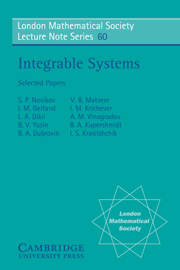Book contents
- Frontmatter
- Contents
- Introduction
- Asymptotic behaviour of the resolvent of Sturm-Liouville equations and the algebra of the Korteweg-de Vries equations (Volume 30, 1975)
- Proof of a variational relation between the coefficients of the asymptotic expansion of the resolvent of a Sturm-Liouville equation (Volume 33, 1978)
- Non-linear equations of Korteweg-de Vries type, finite-zone linear operators and abelian varieties (Volume 31, 1976)
- Methods of algebraic geometry in the theory of non-linear equations (Volume 32, 1977)
- Algebraic curves and non-linear difference equations (Volume 33, 1978)
- The structures of Hamiltonian mechanics (Volume 32, 1977)
- What is the Hamiltonian formalism? (Volume 30, 1975)
The structures of Hamiltonian mechanics (Volume 32, 1977)
Published online by Cambridge University Press: 05 November 2009
- Frontmatter
- Contents
- Introduction
- Asymptotic behaviour of the resolvent of Sturm-Liouville equations and the algebra of the Korteweg-de Vries equations (Volume 30, 1975)
- Proof of a variational relation between the coefficients of the asymptotic expansion of the resolvent of a Sturm-Liouville equation (Volume 33, 1978)
- Non-linear equations of Korteweg-de Vries type, finite-zone linear operators and abelian varieties (Volume 31, 1976)
- Methods of algebraic geometry in the theory of non-linear equations (Volume 32, 1977)
- Algebraic curves and non-linear difference equations (Volume 33, 1978)
- The structures of Hamiltonian mechanics (Volume 32, 1977)
- What is the Hamiltonian formalism? (Volume 30, 1975)
Summary
Introduction
The account we present of the foundations of Hamiltonian mechanics and its mathematical language — the Hamiltonian formalism — represents the contents of a course oflectures given by A. M. Vinogradov in the Faculty of Applied Mathematics at the Moscow Institute of Electronic Machine Construction in the Faculty of Mechanics and Mathematics at the Moscow State University, and at the eighth Voronezh winter school. What these lectures aimed at was a logical account of mechanics, for example, the question when basic facts can be derived from basic concepts by “rules of grammar”. Since the language of Hamiltonian mechanics is the calculus of differential forms and vector fields on smooth manifolds, the basic formulae of this calculus play the role of such grammatical rules. A pleasant consequence of this approach is the possibility of avoiding the manner of arguing by calculations which is usual in analytical mechanics.
Lack of space prevents us from considering more special questions (non-holonomic systems, the theory of impact and refraction, friction, optimal control). So we only remark that they too admit a very simple invariant treatment starting out from the point of view we have taken. We have also not described the natural connection of mechanics with the general theory of differential equations, which is a problem of paramount importance. The algebraic—logical side of this connection is indicated in [16]; for the geometrical basis see [10] and [13].
- Type
- Chapter
- Information
- Integrable Systems , pp. 173 - 240Publisher: Cambridge University PressPrint publication year: 1981
- 3
- Cited by



